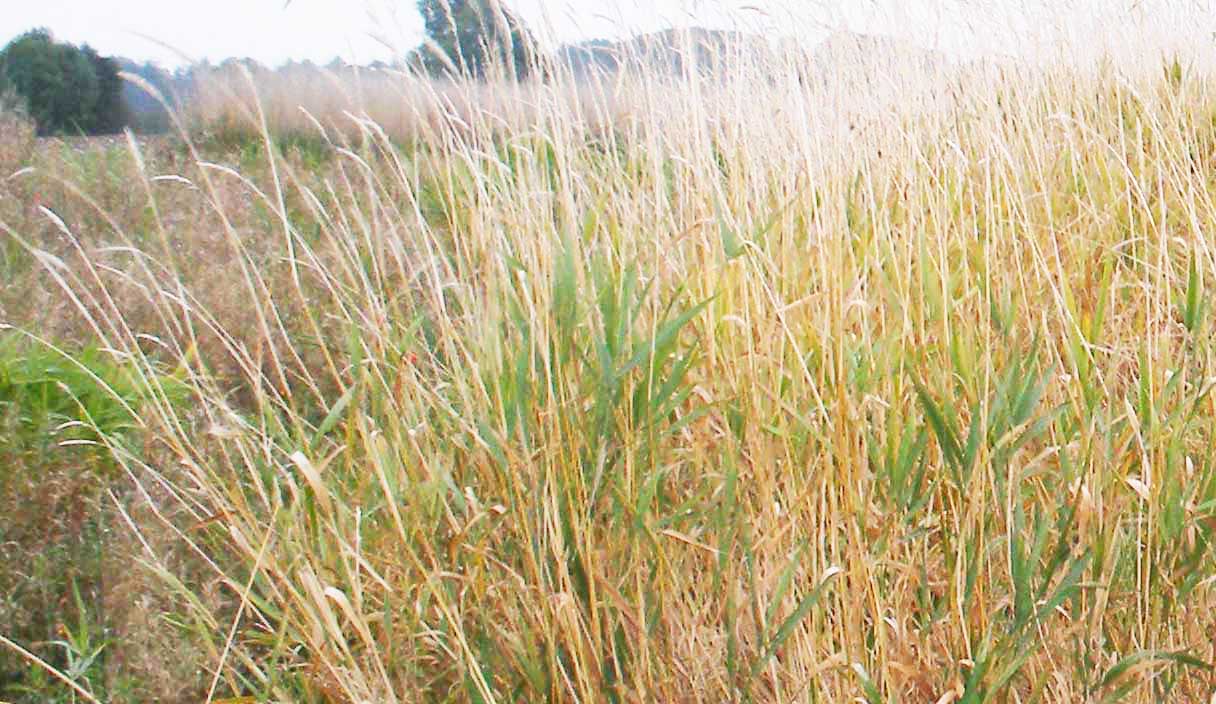Analysis of Reed Canary Grass

Background
Reed canary grass (RCG) is a perennial C3 grass that is: indigenous to northern Europe; adapted to short vegetation periods and low temperatures; can be established by seed; and is safe from overwintering. It can reach a canopy height of 1.5 to 3 metres and, like Miscanthus, has a vigorous rhizome system. It has been used as a forage crop, mainly in North America.The crop can be harvested in the late summer or there can be a delayed harvest in the spring. The relatively dry spring crop can easily be cut with normal equipment for hay harvesting. As with the harvest of all grasses, the cutting height should be as low as possible without causing soil and stone contamination. Pahkala (2001) showed that where RCG was cut at a height of 10cm, the resulting yield was 26%-29% lower than that from a cutting height of 5 cm.
There has been much research in Scandinavia on the use of reed canary grass for energy and fibre purposes. The crop is particularly suited for that region due to its toleration of cold climates and its ability to be grown on cut-away peat land.
Breeding programs that attempted to develop varieties for biofuel production were initiated in the early 1990s in Sweden and Finland.
Reed canary grass yields are often dependant on the soil; yields are much higher on soils with less than 15% of clay than on clay soils. The highest yields in a series of trials in Sweden were obtained on humus-rich soils; on average, over 8 harvest years, the yield was 9 tonnes of dry matter per hectare when harvested in autumn, and 7.5 tonnes of dry matter per hectare at spring harvest (Landstrom, 1999). As with Miscanthus, an autumn harvest yields more crop, with a greater proportion of leaves, but at a higher moisture content.
Fertilisation increases yields, but only up to a level of approximately 100 kg N/ha. On mineral soils more nitrogen fertilizer is likely to be required than for Miscanthus or switchgrass.
Christian and Riche (2000) grew reed canary grass over six years in Rothamstead, England. They found that the highest yield was obtained in the second year and that yields decreased as the crop matured further. It was uncertain as to whether these yield reductions were due to a loss of vitality, lodging problems, or damage caused by larvae.
An EU-funded study evaluated fifteen genotypes, including the commercial variety Palaton, with all populations harvested with a forage plot harvester in late summer/autumn and early spring (delayed harvest). The results were associated with the region of production, with the Irish plot and three from the UK labelled as Western Plots; associated with warm and wet climates. It was found that, for the highest yielding varieties, this region had greater production than either the northern or southern regions. The highest yielding western variety had a mean yield of 12.5 dry tonnes per hectare. Delaying the harvest resulted in yields dropping by between 2% and 37%, depending on the genotype. There was significant damage to RCG resulting from the larvae of the grass moth, Opomea, in the trials at Rothamstead, England. The stem to leaf proportion (by mass) was on average 75% stem in the spring harvest and 65% stem in autumn.
Analysis of Reed Canary Grass at Celignis
Celignis Analytical can determine the following properties of Reed Canary Grass samples:
Sugars (Monosaccharides)
Sugar Alcohols and Uronic Acids
Lignin and Extractives
- Lignin (Klason)
- Lignin (Klason - Protein Corrected)
- Lignin (Acid Soluble)
- Acid Insoluble Residue
- Extractives (Ethanol-Soluble)
- Extractives (Water-Soluble)
- Extractives (Exhaustive - Water then Ethanol)
- Lignin S/G Ratio
- Extractives (Water-Insoluble, Ethanol Soluble)
- Protein Content of Acid Insoluble Residue
- Carbon Content of Acid Insoluble Residue
- Hydrogen Content of Acid Insoluble Residue
- Nitrogen Content of Acid Insoluble Residue
- Sulphur Content of Acid Insoluble Residue
Amino
Acids
Thermal Properties
- Moisture
- Ash
- Ash (Acid Insoluble)
- Carbon
- Hydrogen
- Nitrogen
- Sulphur
- Oxygen
- Volatile Matter
- Fixed Carbon
- Gross Calorific Value
- Net Calorific Value
- Chlorine
- Ash Shrinkage Starting Temperature (Oxidising)
- Ash Deformation Temperature (Oxidising)
- Ash Hemisphere Temperature (Oxidising)
- Ash Flow Temperature (Oxidising)
- Ash Shrinkage Starting Temperature (Reducing)
- Ash Deformation Temperature (Reducing)
- Ash Hemisphere Temperature (Reducing)
- Ash Flow Temperature (Reducing)
- Thernogram - Under Nitrogen
- Thermogram - Under Air
Major and Minor Elements
Cellulose Content of Reed Canary Grass
Reed canary grass tends to have a similar composition to Miscanthus and switchgrass, with cellulose being the main mass constituent. The cellulose content will be dependent on the productivity of the crop; shorter plants tend to have lower cellulose contents than taller, more productive, plantsClick here to see the Celignis Analysis Packages that determine cellulose content.
Hemicellulose Content of Reed Canary Grass
As with Miscanthus and switchgrass, arabinoxylan is the main hemicellulose in switchgrass with xylose the most abundant hemicellulosic sugar.Click here to see the Celignis Analysis Packages that determine hemicellulose content.
Lignin Content of Reed Canary Grass
The lignin content of reed canary grass will depend on what particular clonal variety is being grown as well as on the productivity of the crop. Smaller plants tend to have a greater leaf:stem mass ratio than taller plants and this means that the lignin and cellulose contents are typically lower whilst the extractives and ash contents are higher.Click here to see the Celignis Analysis Packages that determine lignin content.
Starch Content of Reed Canary Grass
The starch content of reed canary grass varies between the different anatomical components of the plant. Typically it is highest in the leaves, where photosynthesis takes place, and lower in the stems. The starch content can also vary according to the maturity of the plant.Click here to see the Celignis Analysis Packages that determine starch content.
Uronic Acid Content of Reed Canary Grass
Uronic acids are present in the hemicelluloses in reed canary grass and are typically more abundant in the early-stages of growth. Furthermore, the concentrations of uronic acids tends to be greatest in the nodes, lower in the internodes, and at intermediate levels in the leaves.Click here to read more about uronic acids and to see the Celignis Analysis Packages that determine uronic acid content.
Enzymatic Hydrolysis of Reed Canary Grass
We can undertake tests involving the enzymatic hydrolysis of Reed Canary Grass. In these experiments we can either use a commercial enzyme mix or you can supply your own enzymes.We also offer analysis packages that compare the enzymatic hydrolysis of a pre-treated sample with that of the native original material.
Click here to read more about enzymatic hydrolysis and to see the various analysis packages that we offer.
Ash Content of Reed Canary Grass
The ash content of reed canary grass will vary according to the clonal variety and plant productivity.Click here to see the Celignis Analysis Packages that determine ash content.
Heating (Calorific) Value of Reed Canary Grass
Reed canary grass can have an attractive heating value, however the effective heating value will depend on the moisture content of the crop.Click here to see the Celignis Analysis Packages that determine heating value.
Bulk Density of Reed Canary Grass
At Celignis we can determine the bulk density of biomass samples, including Reed Canary Grass, according to ISO standard 17828 (2015). This method requires the biomass to be in an appropriate form (chips or powder) for density determination.Click here to see the Celignis Analysis Packages that determine bulk density.
Basic Density of Reed Canary Grass
At Celignis we can determine the basic density of some suitable biomass samples. The method requires the biomass to be in an appropriate form (chips) for density determination.Click here to see the Celignis Analysis Packages that determine basic density.
| Previous Feedstock | Next Feedstock |
Go Back to List of Feedstocks.
Energy
Crops
Agricultural Residues and Wastes
Industrial Residues and Wastes
Municipal
Wastes
Biorefinery
Products






